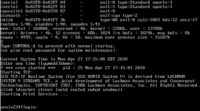Difference between revisions of "XENIX"
ForOldHack (talk | contribs) (→filling in more bones to make this useful :)) |
ForOldHack (talk | contribs) (→Getting this to run easily... :)) |
||
| Line 49: | Line 49: | ||
A history of Xenix: | A history of Xenix: | ||
https://fossbytes.com/xenix-history-microsoft-unix-operating-system/ | https://fossbytes.com/xenix-history-microsoft-unix-operating-system/ | ||
| + | |||
| + | == Emulators with ready to run distributions == | ||
| + | |||
| + | [i286] Architecture | ||
| + | |||
| + | Run Xenix in a browser window! | ||
| + | |||
| + | https://www.pcjs.org/disks/pcx86/unix/sco/xenix/286/2.1.3/ | ||
| + | |||
| + | [x86] Architecture | ||
| + | |||
| + | http://www.hampa.ch/pce/download.html | ||
== Getting this to run == | == Getting this to run == | ||
Revision as of 21:09, 9 March 2019
Xenix was Microsoft port of AT&T UNIX. Based on v6, v7, SYSIII, and later SYSV.
Because of the price of the OS, combined with cheap PC and compatibles, Xenix was the most widespread UNIX until the rise of Linux. Xenix due to its inherent multi-user capabilities became widespread in sales environments with POS (Point of Sales) terminals, and for scheduling systems commonly found in hotels and restaurants. Occasionally you can still find this setup still running on aging hardware.
Xenix was a portable operating system with ports to various platforms, but with the rise of the IBM PC, it primarily became an x86 based OS. Xenix eventually became SCO Unix, then later SCO OpenServer, where it still languishes today.
Contents
Platforms
As mentioned in the OEM guide pdf, Xenix supported the following platforms:
- PDP-11 No versions of this exist online.
- Apple Lisa [M68000) The emulator idle can run this.
- Tandy TRS-80 Model II [Z80A] There are disk images floating around.
- Zilog Z8001 I have only found sales literature that mentions this.
- IBM PC [8088 or x86] This is 'easy' to find.
- IBM 286 [286] As is this version..*
- IBM 386 [386] The 32bit ones will run on Qemu/Virtual PC
- IBM PS/2 [386MC] This version was specifically for MCA computers with a 386 or higher CPU.
Software
A quick list of a few software programs that were available on Xenix. I know the x86 platform was the most supported, I now know that some of these made it to the less popular 68000 platform.
Microsoft
Microsoft made several of their programs in the 1980's available on the Xenix platform. Microsoft Multiplan, and the BASIC Compiler.
Languages:
Applications
- Autodesk AutoCAD 10i
- Microsoft Multiplan (available on the Apple Lisa)
- Microsoft Word v5.0
Databases
- Foxpro
SCO
- SCO Professional
- SCO Lyrix (available on the Apple Lisa)
- SCO Integra
- SCO Manager
- SCO Multiview
A history of Xenix: https://fossbytes.com/xenix-history-microsoft-unix-operating-system/
Emulators with ready to run distributions
[i286] Architecture
Run Xenix in a browser window!
https://www.pcjs.org/disks/pcx86/unix/sco/xenix/286/2.1.3/
[x86] Architecture
http://www.hampa.ch/pce/download.html
Getting this to run
- i386/i286 Xenix 2
- Note: The 286 version of Xenix will only run on a 286 processor or a 286 processor emulator that handles the upper byte of the machine status word, later reserved for use on a 386, by essentially ignoring it, and lettings Xenix use it. A poor programming choice as best.
Available Xenix repositories:
https://archive.org/details/msxenix/history/files/pics/progman5.jpg.~1~
https://winworldpc.com/product/xenix/286
| v • d • e UNIX Versions, Vendors and Related |
|---|
| Research Unix PDP-7 UNIX • V1 • V2 • V3 • V4 • V5 • V6 • V7 • V8 • V9 • V10 • LSX • MINI-UNIX • Unix/32V
AT&T - CB-UNIX • PWB/UNIX • USG UNIX • System III • System IV • System V BSD - 2.9 BSD • 2.10 BSD • 2.11 BSD • 3BSD • 4BSD • 4.1 BSD • 4.2 BSD • 4.3 BSD • 4.4 BSD BSD Descendants 386BSD • NetBSD • FreeBSD • OpenBSD • NeXTSTEP • Darwin |
| Other - xv6 • AMIX • SunOS • Solaris • ULTRIX • A/UX • XENIX • AIX • Dell UNIX |
